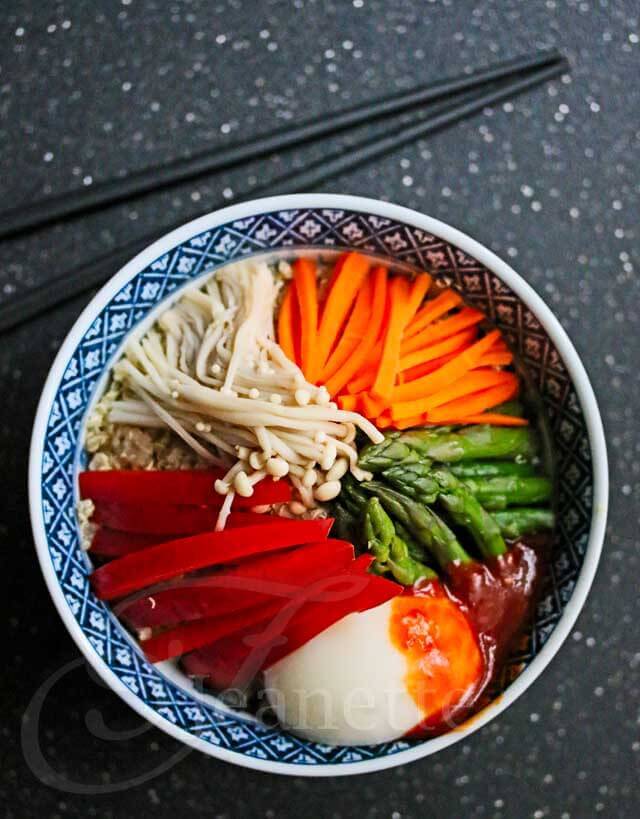This Vegetarian Bibimbap is colorful and fun to eat, and a great way to enjoy a variety of vegetables in one bowl. 
I love Korean food for its full flavored spiciness. One of my favorite parts of eating at Korean restaurant is sampling all the little dishes of banchan that are laid out on the table. Banchan are very easy to make at home. Some banchan that I’ve tried are Bean Sprout Salad, Spinach Salad, quick Napa Cabbage Kimchi, and Spicy Cucumber Salad. The idea is to use a variety of vegetables and simply blanch or serve them raw. They are sometimes lightly seasoned, with just a little salt, or tossed with a little sesame oil and vinegar. Pickled and fermented vegetables (kimchi) are also served as banchan.

Bibimbap is a great way to serve leftover banchan. I think of it as decomposed fried rice in a sense. The base is a scoop of rice (you could also try cooked quinoa), and the toppings are endless. In the Vegetarian Bibimbap I made for this post, I scoured my refrigerator for little bits and pieces of extra vegetables and ended up with a stray red bell pepper, enoki mushrooms, leftover asparagus tips, a carrot, and a few of my sous vide poached eggs. Just a few squirts of a spicy Korean red pepper sauce called gochujang is all you need to pull this together. Bibimbap can be served room temperature if you like, so it’s very low-fuss.

I was inspired to make this bibimbap after spotting a vibrant picture in Cooking Light‘s Global Kitchen cookbook, by New York Times best-selling author, David Joachim.

As many of you know, I love exploring cuisines from around the world. You’ll find recipes that represent all different countries here on my blog, some authentic, some inspired by other cultures, including Asian, Mexican, Middle Eastern, European, African, Peruvian and regional American favorites.
As I flipped through the recipes in Global Kitchen, I was struck by the diversity of the recipes and the beautiful photographs. You’ll find recipes from East Asia & India, Southeast Asia & Australia, The Middle East & Africa, Europe & Eurasia, South America, North & Central America.
Featuring 150 recipes from around the globe, Global Kitchen uses everyday ingredients to make international recipes accessible to the home cook, while keeping recipes on the healthier side. In addition, readers are given a glimpse into culinary customs, tips, cooking techniques and ingredients from the different continents.
As David Joachim points out, eating healthy often means eating “ethnic.” Interestingly, I’ve found this to be especially helpful when I began navigating my way around food-allergy friendly foods several years ago, including gluten-free and dairy-free recipes. Not only did I find many ethnic foods to be naturally gluten-free or easily gluten-free adaptable, but also dairy-free and even more vibrant in flavor and color.
The unique spices and herbs that different cuisines use, as well as the abundance of fresh fresh fruits and vegetables eaten, have expanded my family’s palate and made eating so much more pleasurable. It’s the next best thing to traveling around the world to try different cuisines without the expense.
And now for the giveaway ~ I have one copy of Global Kitchen to giveaway to a reader!

- 1 cup cooked brown rice, warm
- ¼ cup asparagus, lightly steamed, cut into bite size pieces
- ¼ cup carrots, blanched, julienned
- ¼ cup enoki mushrooms, blanched
- ¼ cup red bell pepper, cut into thin strips
- 2 poached eggs
- Korean red pepper gochujang sauce
- Divide rice between two bowls. Arrange asparagus, carrots, enoki mushrooms and red bell pepper on top of rice in a decorative fashion. Top with poached egg and serve with gochujang sauce.
The post Vegetarian Bibimbap Recipe and {Global Kitchen Cookbook Giveaway} appeared first on Jeanette's Healthy Living.
















